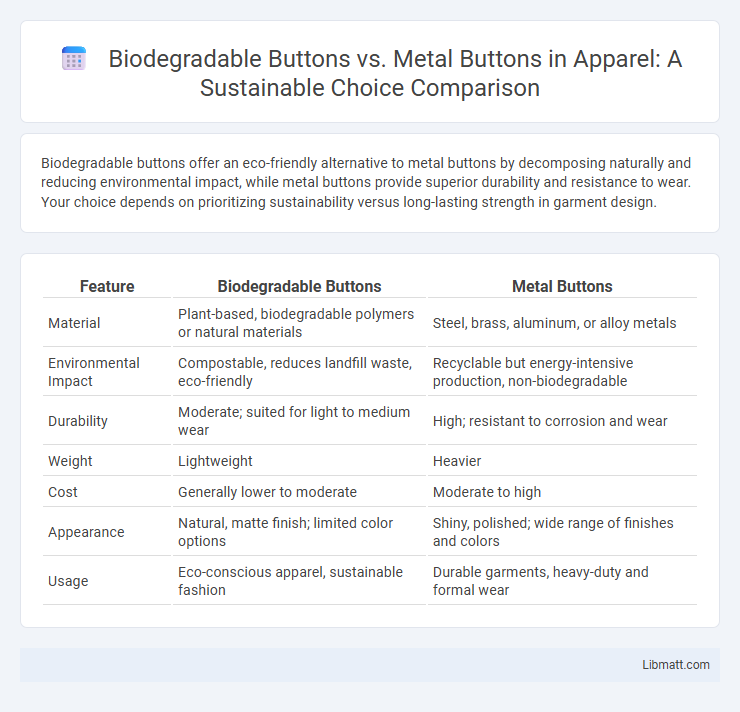Biodegradable buttons offer an eco-friendly alternative to metal buttons by decomposing naturally and reducing environmental impact, while metal buttons provide superior durability and resistance to wear. Your choice depends on prioritizing sustainability versus long-lasting strength in garment design.
Table of Comparison
| Feature | Biodegradable Buttons | Metal Buttons |
|---|---|---|
| Material | Plant-based, biodegradable polymers or natural materials | Steel, brass, aluminum, or alloy metals |
| Environmental Impact | Compostable, reduces landfill waste, eco-friendly | Recyclable but energy-intensive production, non-biodegradable |
| Durability | Moderate; suited for light to medium wear | High; resistant to corrosion and wear |
| Weight | Lightweight | Heavier |
| Cost | Generally lower to moderate | Moderate to high |
| Appearance | Natural, matte finish; limited color options | Shiny, polished; wide range of finishes and colors |
| Usage | Eco-conscious apparel, sustainable fashion | Durable garments, heavy-duty and formal wear |
Introduction to Biodegradable and Metal Buttons
Biodegradable buttons are crafted from natural materials like cornstarch, coconut shell, and wood fibers, designed to decompose quickly and reduce environmental impact. Metal buttons, typically made of steel, brass, or aluminum, offer durability, corrosion resistance, and a premium aesthetic but do not break down naturally in landfills. The choice between biodegradable and metal buttons balances sustainability goals with product longevity and design requirements in fashion and manufacturing industries.
Material Composition: Biodegradable vs Metal Buttons
Biodegradable buttons are typically made from natural materials such as cornstarch, cellulose, or other plant-based polymers that break down safely in the environment. In contrast, metal buttons are composed of alloys like brass, aluminum, or stainless steel, which are durable but do not decompose and can contribute to environmental waste. Your choice between biodegradable and metal buttons impacts sustainability efforts by influencing material decomposition and ecological footprint.
Environmental Impact of Biodegradable Buttons
Biodegradable buttons significantly reduce environmental pollution compared to traditional metal buttons by breaking down naturally within months, preventing long-term waste accumulation. They are often made from renewable materials such as cornstarch or recycled plant fibers, which lower carbon footprints and reduce reliance on mining for metals. Choosing biodegradable buttons aligns with your eco-conscious efforts to minimize landfill waste and support sustainable fashion.
Environmental Impact of Metal Buttons
Metal buttons contribute to environmental degradation through mining activities that cause habitat destruction, soil erosion, and pollution. The extraction and processing of metals require significant energy, leading to increased greenhouse gas emissions and a larger carbon footprint. Unlike biodegradable buttons, metal buttons persist in the environment, contributing to long-term waste accumulation and resource depletion.
Durability and Longevity Comparison
Biodegradable buttons, typically made from materials like cornstarch or resin, offer eco-friendly benefits but generally have lower durability and shorter longevity compared to metal buttons, which are resistant to wear, corrosion, and extreme temperatures. Metal buttons maintain their structural integrity through multiple wash cycles and heavy usage, making them ideal for garments requiring long-lasting fastening solutions. Choosing biodegradable buttons means prioritizing environmental sustainability, but your garments may require more frequent replacements due to the buttons' limited lifespan.
Aesthetic and Design Versatility
Biodegradable buttons offer a wide range of aesthetic possibilities with customizable colors, textures, and shapes that appeal to eco-conscious designers seeking innovation in sustainable fashion. Metal buttons provide a classic, durable look with a polished finish, suitable for traditional or luxury designs requiring long-lasting strength and elegance. Your choice depends on whether you prioritize eco-friendly versatility or timeless durability in your garment's design.
Cost and Availability in the Market
Biodegradable buttons generally cost more than metal buttons due to limited production scale and raw material expenses. Metal buttons are widely available and benefit from established manufacturing processes, making them more affordable and accessible in the market. Your choice may depend on budget constraints and the priority you place on sustainability versus cost-effectiveness.
Applications in Fashion and Textiles
Biodegradable buttons offer an eco-friendly alternative in fashion, ideal for sustainable clothing lines and reducing textile waste. Metal buttons provide durability and a classic aesthetic, often favored in outerwear and heavy-duty garments for long-lasting wear. Your choice between biodegradable and metal buttons can influence the environmental footprint and style appeal of your fashion products.
Consumer Preferences and Trends
Consumer preferences increasingly favor biodegradable buttons due to their environmental benefits and sustainability appeal, aligning with growing eco-conscious trends. Metal buttons remain popular for their durability and aesthetic versatility, yet demand is shifting as more consumers prioritize reducing plastic and metal waste. Your choice between biodegradable and metal buttons reflects a balance between style, function, and ecological impact, mirroring current market shifts toward green fashion solutions.
Future Outlook: Sustainable Choices in Button Manufacturing
Biodegradable buttons represent a significant shift towards eco-friendly fashion by reducing plastic waste and minimizing environmental impact through materials like cornstarch and recycled fibers. Metal buttons, while durable and recyclable, often require resource-intensive mining and processing that contribute to carbon emissions. Choosing biodegradable buttons for your garments aligns with future trends in sustainable manufacturing, promoting circular economy principles and lowering your fashion footprint.
biodegradable buttons vs metal buttons Infographic

 libmatt.com
libmatt.com